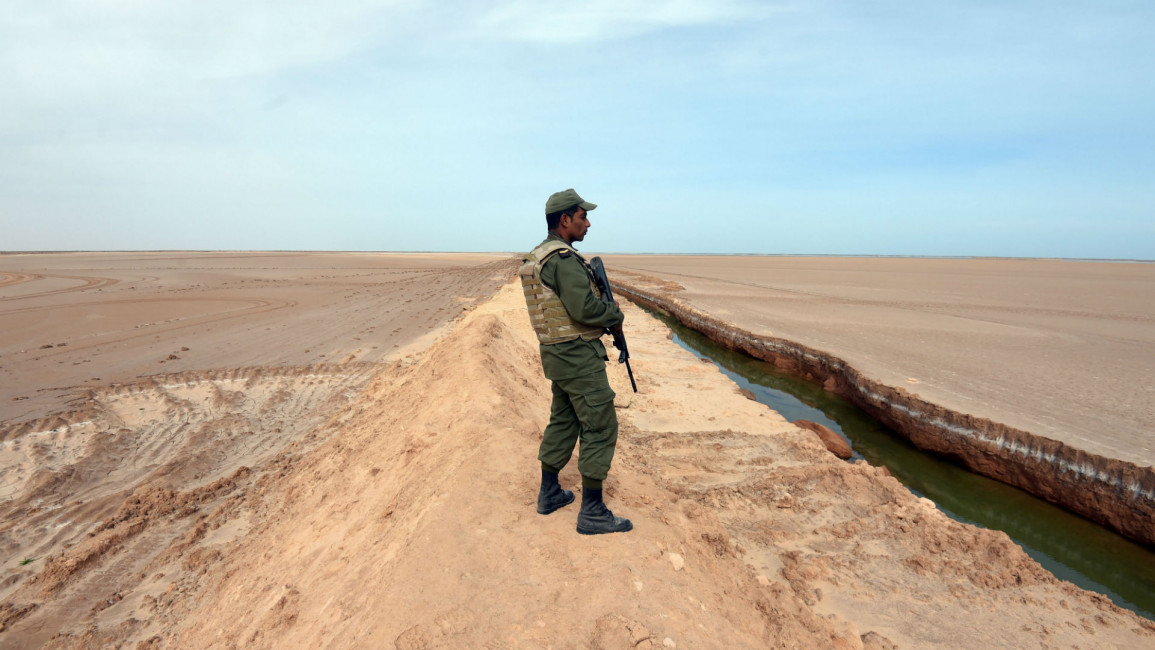Tunisian Red Crescent bracing for impact of Libya intervention
Tunisian Red Crescent bracing for impact of Libya intervention
Humanitarian aid organisations are preparing themselves for huge numbers of refugees from Libya if foreign military intervention begins in the divided oil-rich country, as a border fence comes to completion.
3 min read
Tunisia has constructed a barrier along the border with Libya [Getty]
Humanitarian relief organisations in Tunisia have begun to make preparations for "certain" military intervention in neighbouring Libya, where Islamic State group fighters are gaining ground and influence.
The Tunisian Red Crescent, in coordination with international humanitarian groups, are preparing in southern Tunisia for the potential aftermath of any foreign military intervention in Libya against IS, as the construction of a barrier along the border with Libya reaches completion.
There have been series of mixed messages from a number of western leaders recently about possible intervention in Libya, where recent talks to form a unity government have been marred by disagreements and division.
"We have been coordinating with international organisations to get ready for a sudden influx of refugees from Libya as soon as foreign military intervention starts," Taher Cheniti, the secretary-general of the Tunisian Red Crescent, told The New Arab.
"On Sunday, there will be joint exercises with the Tunisian Ministry of Health and military, Doctors Without Borders, Doctors of the World and the Red Cross," Cheniti said.
He added that, over the past three days, around 3,000 Libyans had crossed into Tunisia each day.
After the 2011 Libyan Civil War, around two million Libyans sought refuge in Tunisia - a number equivalent to one-fifth of the small nation's population.
NATO head Jens Stoltenberg said on Friday he was "following very closely" the situation in Libya, stressing the importance of agreeing a new government "because that will be an important first step to be able to fight IS".
A Libyan official told The New Arab that Italy was gearing up for intervention in the northern African country, with warships being deployed from the southern Italian coast.
About 5,000 IS fighters are now in Libya, a US official said last week, approximately double earlier estimates, while the number of IS extremists in Iraq and Syria has dropped.
Tunisia on Saturday completed the construction of a barrier along its border with Libya, months after attacks on its national museum and a beach resort killed dozens of tourists.
The barrier stretches some 200 kilometres from Ras Jedir on the Mediterranean coast to Dhiba further southwest, across about half the length of the frontier between the two neighbours.
In March last year, 21 tourists and a police officer were killed in a shooting at the National Bardo Museum in Tunis, and in June an attack at a beach resort near Sousse killed 38 holidaymakers. Both attacks were claimed by IS fighters.
IS has established a stronghold in the coastal city of Sirte, Gaddafi's hometown.
Libya has been split between two rival governments since 2014, a consequence of the chaos that engulfed the country after a 2011 uprising toppled and killed long-time dictator Muammar Gaddafi.
The Tunisian Red Crescent, in coordination with international humanitarian groups, are preparing in southern Tunisia for the potential aftermath of any foreign military intervention in Libya against IS, as the construction of a barrier along the border with Libya reaches completion.
There have been series of mixed messages from a number of western leaders recently about possible intervention in Libya, where recent talks to form a unity government have been marred by disagreements and division.
"We have been coordinating with international organisations to get ready for a sudden influx of refugees from Libya as soon as foreign military intervention starts," Taher Cheniti, the secretary-general of the Tunisian Red Crescent, told The New Arab.
"On Sunday, there will be joint exercises with the Tunisian Ministry of Health and military, Doctors Without Borders, Doctors of the World and the Red Cross," Cheniti said.
He added that, over the past three days, around 3,000 Libyans had crossed into Tunisia each day.
Read more: Libyans fleeing violence to Tunisia raise security fears |
After the 2011 Libyan Civil War, around two million Libyans sought refuge in Tunisia - a number equivalent to one-fifth of the small nation's population.
NATO head Jens Stoltenberg said on Friday he was "following very closely" the situation in Libya, stressing the importance of agreeing a new government "because that will be an important first step to be able to fight IS".
A Libyan official told The New Arab that Italy was gearing up for intervention in the northern African country, with warships being deployed from the southern Italian coast.
About 5,000 IS fighters are now in Libya, a US official said last week, approximately double earlier estimates, while the number of IS extremists in Iraq and Syria has dropped.
Tunisia on Saturday completed the construction of a barrier along its border with Libya, months after attacks on its national museum and a beach resort killed dozens of tourists.
The barrier stretches some 200 kilometres from Ras Jedir on the Mediterranean coast to Dhiba further southwest, across about half the length of the frontier between the two neighbours.
In March last year, 21 tourists and a police officer were killed in a shooting at the National Bardo Museum in Tunis, and in June an attack at a beach resort near Sousse killed 38 holidaymakers. Both attacks were claimed by IS fighters.
IS has established a stronghold in the coastal city of Sirte, Gaddafi's hometown.
Libya has been split between two rival governments since 2014, a consequence of the chaos that engulfed the country after a 2011 uprising toppled and killed long-time dictator Muammar Gaddafi.



